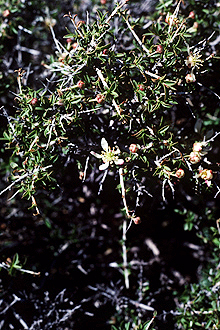Ragged rockflower facts for kids
Quick facts for kids Ragged rockflower |
|
|---|---|
 |
|
| Scientific classification | |
| Genus: |
Crossosoma
|
| Species: |
bigelovii
|
| Synonyms | |
|
Crossosoma parviflorum Rob. & Fern. |
|
The ragged rockflower (scientific name: Crossosoma bigelovii) is a special flowering plant. It belongs to a small plant family called Crossosomataceae. This plant grows naturally in the deserts of North America. You can find it in places like the Mojave, Chihuahuan, and Sonoran Deserts. It has been seen in states such as Arizona, California, and Nevada in the USA. It also grows in Baja California, Chihuahua, and Sonora in Mexico.
What Does the Ragged Rockflower Look Like?
The ragged rockflower is a type of shrub. It can grow to be about 1 to 2 meters (3 to 6 feet) tall. This plant has many branches that spread out in a complex way. The tips of its branches are sharp, like thorns.
Its branches are covered with small, gray-green leaves. These leaves are grouped together in clusters. They are also deciduous, which means they fall off during certain times of the year. Each leaf is usually no longer than about 1.5 centimeters (half an inch).
When the plant blooms, it produces a single flower. This flower grows from a part called the inflorescence. Each flower has 5 petals. These petals can be white or have a light purple color. They are about one centimeter long. The petals become narrower at their bases, forming what looks like small claws.
How People Use the Ragged Rockflower
Sometimes, people use the ragged rockflower as an ornamental plant. This means they grow it because it looks nice. It is often planted in special gardens called habitat gardens. These gardens are designed to look like natural landscapes.
You can grow this plant from its seeds. It needs soil that drains water very well. This makes it a good choice for a desert butterfly garden. Butterflies enjoy visiting these plants.
However, the ragged rockflower can be tricky to grow for most people. It is very sensitive to too much water. If you water it too much, the plant will likely die. It prefers dry conditions, just like its desert home.

